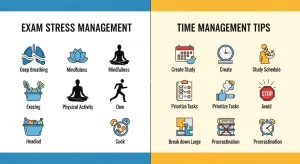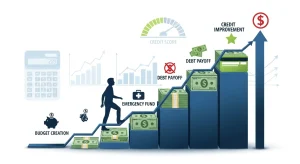Introduction
Building a professional portfolio has become essential for career advancement in today’s competitive job market. Whether you’re seeking new opportunities, changing careers, or aiming to showcase your expertise, a well-crafted portfolio serves as your most powerful marketing tool. This comprehensive guide provides actionable career advice on creating a portfolio that stands out and drives meaningful results.
In 2025, portfolios aren’t decorative museums — they’re sales pages, designed to convert viewers into opportunities. Let’s explore how to build a portfolio that elevates your career trajectory and positions you as a top candidate in your field.
Language Learning Tips: Expert Strategies for Mastering Any Language Fast
What is a Professional Portfolio?
A professional portfolio is a curated collection of your best work, achievements, and professional experiences that demonstrates your skills, expertise, and career progression. A career portfolio can help illustrate your professional accomplishments, talents, abilities, activities, and attitudes to prospective employers.
Unlike a traditional resume, a portfolio provides tangible evidence of your capabilities through:
- Work samples and case studies
- Project outcomes and metrics
- Testimonials and recommendations
- Skills demonstrations
- Professional achievements
- Career milestones
Why Building a Portfolio Matters for Career Development
1. Competitive Advantage in Job Markets
Having a professional portfolio can advance your career: get new clients, grow your professional network, and help you reach more people. In competitive industries, portfolios differentiate you from candidates who only submit resumes.
2. Career Transition Support
For professionals changing industries or roles, portfolios bridge experience gaps by showcasing transferable skills and relevant projects. This career advice proves particularly valuable when pivoting to new fields.
3. Professional Credibility
The career portfolio also serves as a marketing tool, offering employers a preview of your performance as a potential employee. It builds trust by providing concrete evidence of your capabilities.
How to Learn New Skills Online: Complete Guide to Online Learning Success
How to Build a Professional Portfolio: Step-by-Step Guide
Step 1: Define Your Portfolio Goals and Audience
Before creating content, establish clear objectives:
- Career Goals: Determine whether you’re seeking promotion, career change, or client acquisition
- Target Audience: Identify who will view your portfolio (hiring managers, clients, recruiters)
- Industry Requirements: Research portfolio standards in your field
Step 2: Choose Your Portfolio Format
Select the format that best serves your career objectives:
- Digital Portfolio Website
- Most versatile and shareable
- Easy to update and customize
- SEO-friendly for online visibility
- PDF Portfolio
- Professional for email attachments
- Consistent formatting across devices
- Suitable for formal applications
- Physical Portfolio
- Ideal for in-person interviews
- Tangible impact during presentations
- Works well for creative fields
Step 3: Select and Organize Your Best Work
Quality over quantity. Choose pieces that reflect your strengths. Focus on:
- Relevant Projects: Align selections with target roles
- Measurable Results: Include metrics and outcomes
- Diverse Skills: Demonstrate range and adaptability
- Recent Work: Prioritize current and relevant examples
Step 4: Create Compelling Case Studies
Transform work samples into engaging narratives:
- Challenge/Problem: Describe the initial situation
- Process/Approach: Detail your methodology
- Solution/Implementation: Explain your actions
- Results/Impact: Quantify outcomes and benefits
Step 5: Optimize for Search and Discovery
For digital portfolios, implement SEO best practices:
- Use relevant keywords naturally throughout content
- Create descriptive page titles and meta descriptions
- Include alt text for images
- Ensure mobile responsiveness
- Improve loading speed
Fitness Routines at Home Without Gym: Complete Guide to Bodyweight Workouts
Essential Portfolio Sections
Professional Summary
Craft a compelling introduction that:
- Summarizes your expertise and value proposition
- Highlights key achievements
- Aligns with target role requirements
- Includes relevant keywords for your industry
Skills and Competencies
Include technical or hard skills that are specific to your role and also consider highlighting your soft skills. Organize skills into categories:
- Technical Skills: Software, tools, programming languages
- Industry Skills: Specific methodologies or processes
- Soft Skills: Leadership, communication, problem-solving
- Certifications: Relevant credentials and training
Work Samples and Case Studies
Present your best projects with:
- Clear project descriptions
- Your specific role and contributions
- Challenges overcome
- Measurable results and impact
- Visual elements (screenshots, images, charts)
Education and Professional Development
Include:
- Degrees and certifications
- Relevant coursework
- Professional training programs
- Industry workshops and seminars
- Continuing education efforts
Contact Information
Always include a clear, up-to-date contact section or page with:
- Professional email address
- LinkedIn profile
- Phone number
- Professional social media profiles
- Location (if relevant)
Healthy Eating & Nutrition Basics: Your Complete Guide to Better Health
Portfolio Building Tips for Different Career Stages
Entry-Level Professionals
- Include academic projects and internship work
- Showcase volunteer experiences
- Create mock projects demonstrating skills
- Emphasize potential and learning agility
- Include relevant coursework and certifications
Mid-Career Professionals
- Focus on leadership and management experiences
- Highlight cross-functional collaboration
- Demonstrate career progression
- Include mentoring and training contributions
- Show industry expertise development
Senior-Level Professionals
- Emphasize strategic contributions
- Showcase team and organizational impact
- Include thought leadership content
- Highlight industry recognition
- Demonstrate business results and ROI
Where to Find the Best Free Online Courses for Learning English
Common Portfolio Mistakes to Avoid
1. Information Overload
Only include items that are necessary to your career pursuits. Avoid cramming everything you’ve ever done into your portfolio.
2. Poor Organization
Use clear sections, labels, and navigation to make your portfolio easy to navigate and understand.
3. Outdated Content
Keep your portfolio current with recent work and achievements. Remove outdated examples that no longer represent your capabilities.
4. Weak Visual Design
Invest in professional presentation. Poor design can undermine even excellent work samples.
5. Missing Contact Information
Always make it easy for potential employers or clients to reach you.
How a Student Achieved Fluent English in One Year Without Moving Abroad
Measuring Portfolio Success
Track your portfolio’s effectiveness through:
- Application Response Rates: Compare before and after portfolio implementation
- Interview Invitations: Monitor increased interview opportunities
- Professional Inquiries: Count unsolicited contact from recruiters or clients
- Website Analytics: Track views, engagement, and contact form submissions
- Networking Results: Measure improved professional connections
Frequently Asked Questions
What should I include in my first professional portfolio?
Start with your best academic projects, internship work, volunteer experiences, and any freelance or personal projects that demonstrate relevant skills. Include a professional summary, skills section, and contact information. Focus on quality over quantity – 3-5 strong examples are better than 10 mediocre ones.
How often should I update my career portfolio?
Update your portfolio every 3-6 months or whenever you complete significant projects, achieve new certifications, or change career direction. Regular updates ensure your portfolio reflects your current skills and recent accomplishments, keeping you ready for unexpected opportunities.
Can I create a portfolio without extensive work experience?
Absolutely. Include academic projects, volunteer work, personal projects, bootcamp assignments, or mock projects that demonstrate your skills. Many successful portfolios feature hypothetical case studies that showcase problem-solving abilities and technical competencies relevant to your target role.
9 Common SEO Mistakes That Can Hurt Your Website Ranking
Take Action: Start Building Your Portfolio Today
Building a professional portfolio is an investment in your career future. Start by identifying your best work samples and organizing them into a coherent narrative that showcases your unique value proposition.
Ready to accelerate your career development? Explore premium portfolio templates and career coaching resources to create a standout professional presence.
Office Setup & Productivity Tools :
Online Course Platforms & Software:
Conclusion
Creating a professional portfolio is one of the most effective career advice strategies you can implement. By following this comprehensive guide, you’ll build a portfolio that not only showcases your expertise but actively advances your career goals. Remember that portfolio building is an ongoing process – continue refining and updating your portfolio as your career evolves.
Your portfolio is more than a collection of work samples; it’s your professional story told through tangible achievements and demonstrable skills. Start building today, and watch as new opportunities begin to unfold in your career journey.











